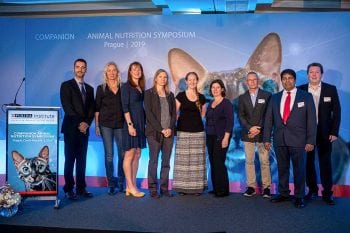At the time of writing, I had just returned from a veterinary symposium in Prague, which was a fascinating and useful learning experience, with scientists and vets gathering from all over Europe, North America and Asia to share knowledge.
The event was organised by the Purina Institute – the voice representing the global Purina research and development team of more than 500 scientists and pet care experts, working across a network of eight research and development facilities in the US, Europe, South America, Australia and Singapore.
The mission of the institute is to advance the science of pet nutrition, with the overall aim of improving pet health and welfare by learning more about how best to feed them. Regular international seminars are held to allow the Purina Institute to share the latest nuggets of useful science with scientists and vets who are keen to learn more.
Over past decades, many examples of nutritional advances have been discovered by Purina scientists – including the impact of nutrition on brain health and gastrointestinal disorders, as well as a better understanding of how to achieve optimal bodyweight in pets.
Studies have shown 83% of pet owners completely trust their vet to provide helpful information about the food they feed their pet, but less than 1 in 4 (22%) of vets actually start the conversation about pet nutrition.
New discoveries
The Purina Institute aims to provide vets with top-quality science-based information about pet nutrition, giving them the knowledge and confidence to initiate conversations about feeding their pets.
We all know pets are what they eat – just like ourselves – yet, it’s all too easy to forget this when it comes to the daily task of feeding them. It would benefit pet health and welfare significantly if we all – vets and pet owners – gave more attention to this part of our pets’ lives.
All of the lectures and meetings held by the Purina Institute are focused on nutrition in some way, but it’s far broader than just talking about what to give pets to eat. The range of subjects discussed at the Prague Companion Animal Nutrition Symposium was typical of the wide variety: the overall theme was simply “the science of cats”.
The first topic at the event was an unusual one for a vet conference: new discoveries about the science of humans being allergic to cats. Cat allergies affect up to 20% of the adult population, and are a major reason for people not keeping cats and for cats having to be rehomed.
The allergy in humans is caused by sensitivity to the major cat allergen (Fel d1), which is secreted through the cat’s saliva and spread across its body by grooming, then released into the home on skin cells (dander) and hair.
People who are allergic to cats find it impossible to be near them, which is the source of a great deal of frustration for many people who would love to share their lives with a cat.
Safe approach

The science, presented at the symposium by Nestlé director of molecular nutrition Ebenezer Satyaraj, offered an exciting new way of solving this problem.
Research has demonstrated that when cats are fed a kibble coated with an egg-product ingredient containing an antibody to this Fel d1 allergen, when they chew, the allergen in the saliva is neutralised inside the cat’s mouth. This occurs before it can be spread around the cat’s body by grooming and, ultimately, into the environment.
Studies have shown not only a significant drop in the amount of active allergen in the saliva, but also, on average, a 47% reduction in active Fel d1 on their hair starting with the third week of feeding. This holds the possibility that people who are allergic to cats can live with them. The approach is safe for the cat and does not interfere with its natural production of Fel d1, nor impact its overall physiology – the allergen is simply neutralised.
The antibody to the Fel d1 allergen is produced in eggs by exposing hens to Fel d1: the type of antibody is known as an IgY. This is the type of Ig that is the major antibody in birds and reptile blood. It is also found in high concentrations in chicken egg yolk (hence the “Y”). As with the other Igs, IgY antibodies are formed by the immune system in reaction to certain foreign substances and specifically recognise them.
In the past, IgY has sometimes been mislabelled as Immunoglobulin G (IgG) due to its functional similarity to mammalian IgG and IgE. However, IgY differs both structurally and functionally from mammalian IgG, and does not cross-react with antibodies raised against mammalian IgG.
Since chickens can lay eggs almost every day, and the yolk of an immunised hen’s egg contains a high concentration of IgY, chickens have become increasingly popular as a source of customised antibodies for research.
It has been known for years eggs can be used like this to produce antibodies that can be eaten: the same principle has been used as a way of creating oral antibodies to some gastrointestinal bacteria and viruses. In this case, the antibody is exerting its action against the Fel d1 antigen in the cat’s saliva, before it then makes its way to the cat’s GI tract, where it’s digested just like every other protein.
The fact IgY can be used to neutralise feline allergens is a new scientific finding that’s just been announced; it has not yet translated into a product on the marketplace. However, it’s such a promising finding and Purina expects to share product news within a year.
This is not only good news for allergic humans who may now be able to keep cats, but also great news for the many thousands of cats in rescue centres, waiting for good homes. It’s hoped by the end of 2020, thousands of new homes will be able to take in cats as pets because of this new way of tackling cat allergies.
The news about this new way of tackling human allergies to cats was the main new message announced at the symposium, with a follow-up lecture from Andrew Sparkes that detailed research demonstrating the significant effect a solution to the problem would have on cat welfare, by dramatically increasing the number of new homes available for cats.
Day two
The second day of the symposium included useful updates on other aspects of feline nutrition.
Jessica Quimby of The Ohio State University, who is board-certified in feline internal medicine, discussed the latest thoughts on management of feline kidney disease.
Andrea Fascetti – a professor of nutrition at the University of California, Davis, who is a diplomate of both the American College of Veterinary Internal Medicine and the American College of Veterinary Nutrition – gave an update on the role of taurine and carnitine in cardiac health. Dr Fascetti may be known to readers of Veterinary Times as the co-author of Applied Veterinary Clinical Nutrition, regarded by many as the “bible” of the world of pet nutrition.
Finally, Calin Heinze gave an inspiring talk titled “If cats could talk: using cat behaviour to our advantage to maintain a healthy weight and mind”. She explained how normal cat behaviour could be used to encourage obese cats to lose weight (for example, using toys that encourage cats to work for their dinner).
The underlying message from the symposium was if pet owners want to know more about pet nutrition, they should talk to their vet. We may not always start the conversation, but we do like talking about it – and with the help of professional nutritionists to teach us, we vets are still the best way for people to learn the truth about what they feed their pets.
